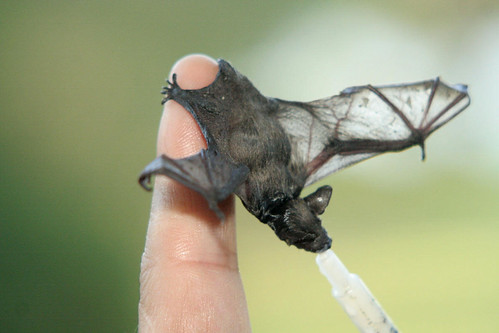Q: I have been comparing bat houses and I wanted to know if there is a benefit to having a base at the bottom of the house vs not having a base to prevent the possible fall of a baby bat? I know not having a base is an advantage to not have birds nest in the house, but I am concerned about the safety of baby bats?
My response:
 Thank you for the excellent question! Its amazing how bat mothers take care of their young. Bats share MANY of the same behavioral qualities as humans do. Bat mothers will take great care of their young and nurse them for the first two weeks of their life. After that the babies learn to fly and begin to hunt for bugs!
Thank you for the excellent question! Its amazing how bat mothers take care of their young. Bats share MANY of the same behavioral qualities as humans do. Bat mothers will take great care of their young and nurse them for the first two weeks of their life. After that the babies learn to fly and begin to hunt for bugs!Just think of other animals, such as horses or cows, that can walk only moments after being born, or chicks that have to hatch themselves from their eggs. The act of the baby bats holding onto their mothers and holding onto the sides of the bat house strengthens them for their very long (average of 40 years) and happy bat lives!
Within the two weeks that the babies are still growing strong, getting ready to learn to fly, they live inside the chambers of the home, holding onto their mother and the grooved sides of the chambers.
 In nature, bats would live upside down in caves, mines, barns, attics, and some in the bark of trees. Bats have been around since the age of the dinosaur and have developed the amazing ability to live hanging upside down! In nature, these baby bats do not need a safety net. Bats prefer the open bottom bat house as they can easily locate and land on the landing pad that extends below the chambers and the box.
In nature, bats would live upside down in caves, mines, barns, attics, and some in the bark of trees. Bats have been around since the age of the dinosaur and have developed the amazing ability to live hanging upside down! In nature, these baby bats do not need a safety net. Bats prefer the open bottom bat house as they can easily locate and land on the landing pad that extends below the chambers and the box.I think bats are just amazing animals, so much so, that I wrote a little book to help people manifest successful bat homes. I include great literature along with the bat homes I sell. My husband, who is also a huge bat
 enthusiast, has been a professional carpenter for over 20 years. Together we build our bat homes and look to provide the HIGHEST quality bat home for the most affordable price.
enthusiast, has been a professional carpenter for over 20 years. Together we build our bat homes and look to provide the HIGHEST quality bat home for the most affordable price.Closed bottom Bat Houses are more common in Europe, however, they are larger and require regular maintenance. You would have to take a hose and regularly spray the inside of the bat house (while the bats are not currently home) to clean the build up of urine and guano. If you did not clean it regularly, the build up would increase the bat colonies chances of becoming sick or catching parasites.
Studies have shown that once a bat colony has chosen your bat house, they will return year after year. If you have chosen a good bat house they can last longer then 10 years. By using open-bottom designs, even bat houses abandoned by their human owners will remain available to bats for a long time.
Another point I would like to make is that bats are extremely clean animals, they spend most of their waking day time hours grooming themselves and each other. Since a bat house with a closed bottom would not only make it harder for them to land and enter, it would also collect all their guano (bat droppings) as well as their urine. A much healthier design is the free bottom. Most gardeners love collecting the guano for their compost as it makes an excellent fertilizer.

